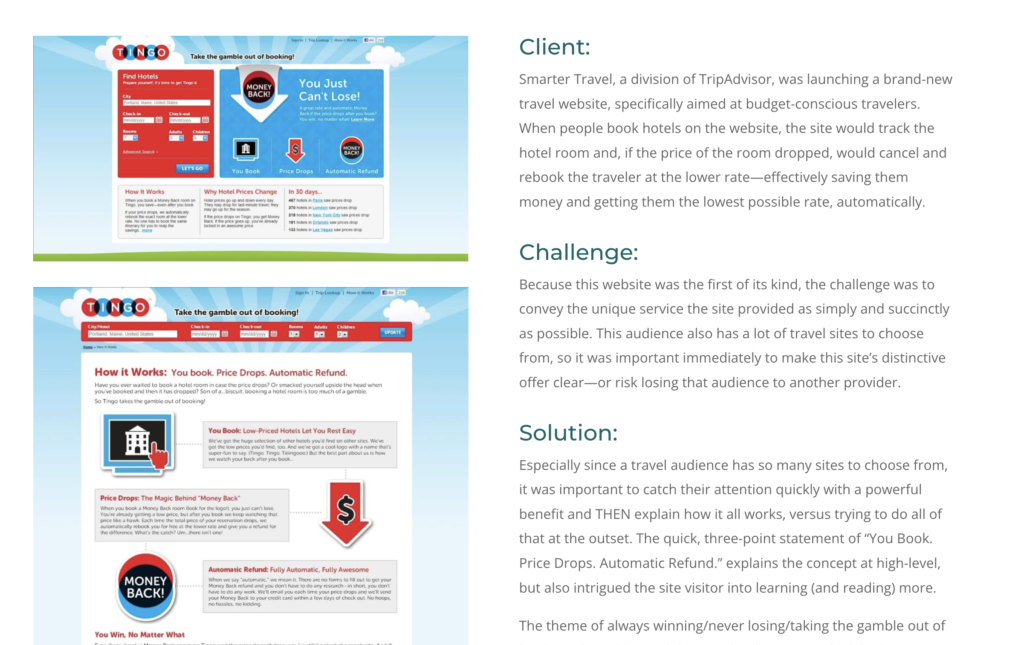
You already know that a portfolio site is essential for copywriters—no ifs, ands, or buts. (And luckily, there are plenty of sites that make creating your own site super easy. No sweat!) But there are several common copywriting portfolio mistakes our team sees time and time again that can mean the difference between landing work and having clients leave your page.
Your portfolio site is a copywriting project just like any other. You have a client (in this case, you), a target audience (potential clients and bosses), and a goal you want to accomplish (to get them to contact you).
But even knowing that, it’s easy for a lot of copywriters to get overwhelmed with writing about themselves. And, because I’d never leave you hanging, let’s talk about what those copywriting portfolio mistakes are—and how to fix them.
The 4 Most Common Copywriting Portfolio Mistakes
1. No benefit to consumer. (#1 Copywriting Portfolio Mistake!)
It’s one thing to know that every copywriting project needs to focus on the benefit…but it’s another thing to remember to include it, especially on your own site. Your benefit to consumer—that is, how your copywriting benefits the people who will hire you—needs to be prominent.
This is the biggest copywriting portfolio mistake and it could cost you clients. If you don’t have a clear, compelling benefit to them from the get-go, they may not scroll past your headline!
How to Fix It
Your homepage headline, the first thing they see when they land on your website, needs to purposefully and powerfully convey your benefit to consumer.
And make sure you convey the END benefit. Sure a company wants its audience to “fall in love” with them…but what’s the end benefit of that? What does a company REALLY want that copy to do? What’s a company’s main goal? (Hint, hint: Companies only exist if they make sales.)
How is your copy going to build that company and help it succeed? Remember, this site is all about conveying how your copywriting work will benefit a company and you are the right person for the job. You HAVE to tell them.
2. Your “About Me” page is about you.
I know, that seems a little silly. The page is called “About Me” so it should be about you, right? Nope! Remember the purpose of your website. Your “About Me” page is all about how YOU can benefit your clients. In reality, your About Me page is all about…them.
How to Fix It
So, your About Me page needs to help them understand why you are uniquely able to help them, and then explain exactly how you can help them.
Start your About Me page with your USP, showing them exactly how unique elements from your background have made you an especially adept copywriter, and then follow that up with how your copywriting benefits their company.
Then, at the bottom, if you want to, you can talk about the extracurricular elements of your life to give them a feel for who you are as a person. But this all comes last—remember, About Me is about them.
3. No project descriptions.
Second to having no benefit to consumer, not including write ups about each of your projects is the next worst copywriting portfolio mistake.
Well yes…and no. Your copywriting samples (whether client work or spec work) should definitely demonstrate both your ability to write compelling, effective copy and your ability to collaborate with a designer.
But there’s more to those pieces than just the results, right? There’s all the thinking that went into it—and that can help demonstrate your value to potential clients even more.
How to Fix It
Each piece in your portfolio should include background about the company/organization (who they are and what they do), the purpose and challenge of the project (what you were tasked with doing and why), and how you solved the challenge (the strategy you used to meet the goal).
You’re pulling back the curtain to give potential clients insight into WHY you made the choices that you did and, thus, demonstrating the strategic thinking that’s behind each project.
This holds true for spec pieces too, by the way. You filled out a creative brief and came up with a project yourself, but you still also used strategic thinking to meet those objectives. Just be sure, of course, not to write the description as if the company had actually asked you to do the work.
4. Too much education.
It’s very tempting for copywriters to use space on their sites to educate visitors about why copywriting is important and valuable.
But let’s think for a minute about the customer journey—about how a visitor actually gets to your site. Here are the possible scenarios: they arrived there because they interacted with you about copywriting and you directed them to take a look, they were referred there by a colleague or contact, or they searched for copywriters somewhere and found your site.
In each of those scenarios, the visitor knows what copywriting is and knows that they need a copywriter. You don’t need to educate them about the value of copywriting—they already know it, AND you’re wasting valuable copy when you could be selling them on why you’re the right copywriter for the job.
No one’s going to be stumbling onto a copywriter’s website with no idea of what copywriting is, except maybe your grandparents if your mom has proudly passed along your URL. But your grandparents are not your target audience. (Much as you love them.)
By the time someone gets to your site, they know what copywriting is (either because they already knew or you made a compelling case for the service in a pitch email) and now they’re evaluating whether or not to get in touch with you.
How to Fix It
This fix is easier said than done: you need to remove any education about copywriting. Some of these may be easy to spot. For example, “Copywriting is writing that is designed to help your business grow,” falls firmly in the education camp.
Other lines may be sneakier. For example, “You want your business to grow, right? Effective messaging is the key to helping you do that.” Remember: they are interested in copywriting. So, why you and not another copywriter?
If you have a ton of information that’s educational, but you still think is valuable, consider adding it to your blog (if you have one).
As with any other copy project, you need to carefully evaluate each and every single word to make sure it’s essential and that it’s doing the job you need it to do.
And here’s a little bonus one:
If you have a blog on your site (which you don’t have to), it needs to be geared toward your target audience, too.
That means it has to have posts with topics that are useful to prospective clients or bosses. Your travel diaries or musings about Netflix shows have no place on your professional site. Neither do posts complaining about copywriting clients. Or posts meant for other copywriters.
Remember, too, that some of your posts might talk about WHAT copy pieces are important and WHY, but never about HOW to write them. How to write them is what they hire you for. 🙂
Copywriting Portfolio Inspiration
Looking for some portfolio inspiration? Check out some of our favorite copywriting portfolios with insight into why they’re so effective.
Watch for More Copywriting Portfolio Tips
On Episode 43 of the Build Your Copywriting Business podcast, Nicki and Kate dig further into the four common copywriter portfolio mistakes and how you can ensure you avoid them on your own portfolio site.
Your turn! Did any of these copywriting portfolio mistakes trip you up on your own portfolio site? (There’s no shame in it! I called them “common mistakes” for a reason.) And, if so, are you committed to fixing them ASAP? Let me know in the comments below.
Last Updated on June 30, 2023

Helpful! Thanks, Nicki.
Hi Josie,
Great! I’m glad – that’s always the goal. 🙂
Thanks for commenting!
Nicki
Awesome Post!
Hi Yaseen,
I’m glad you liked it!
Thanks for commenting!
Nicki
Thanks, Nikki for the post
Hi Isaac,
You’re welcome! I’m glad you enjoyed it. 🙂
Thanks for commenting!
Nicki
Hmmm…?
Hi there! Thanks for the post. On the point about leaving our travel diaries and musings about Netflix elsewhere, I had thought differently about this, particularly for beginners in the industry. If there are gaps in your portfolio or it is limited, I would believe that any writing (once engaging and thoughtful) is a good idea to include as it shows initiative, genuine love for your craft and that you are a versatile writer.
Of course, within reason! I am suggesting 2-3 passion project posts at most. Like, a short story shows your ability to write longform.
What do you think?
Jenni
That’s a great question and a valid point. Here are links to a blog post and a podcast where Nicki and Kate dig into this a bit more!
https://filthyrichwriter.com/copywriting-qa-where-content-belongs-on-your-copywriting-portfolio-site/
https://filthyrichwriter.com/podcast/how-copywriters-can-successfully-add-content-as-a-service/
Thanks a million, Nicki, that was an eye-opener, honest, and straight to the point.
Thanks for the feedback – so glad you enjoyed the post!